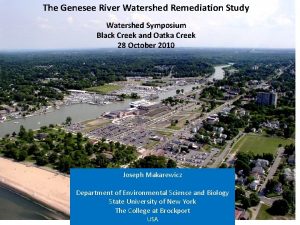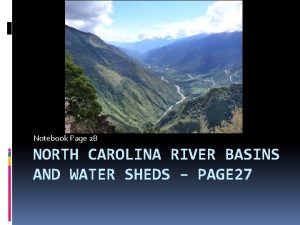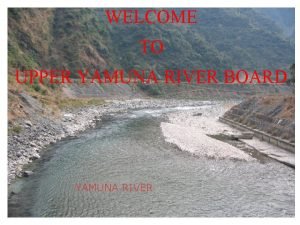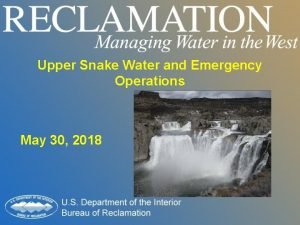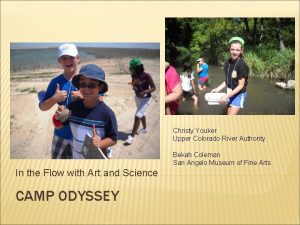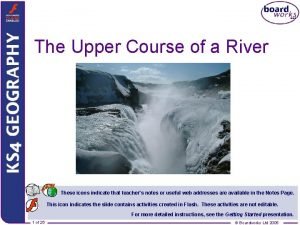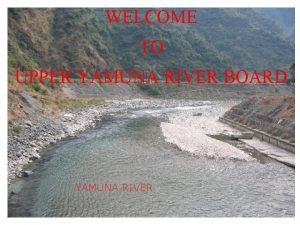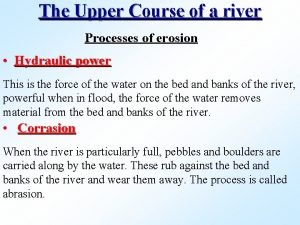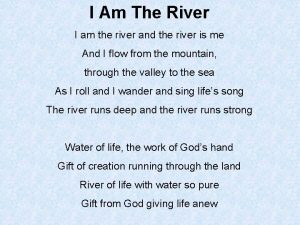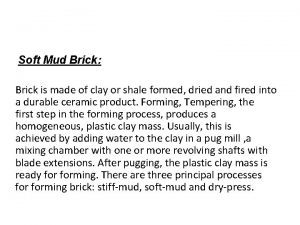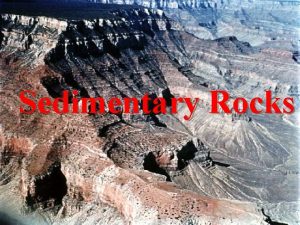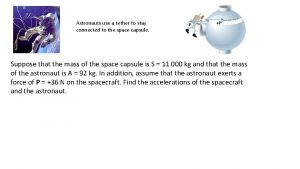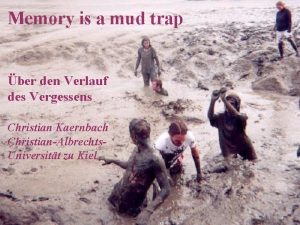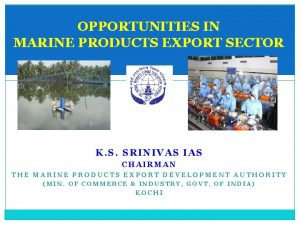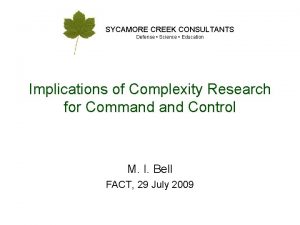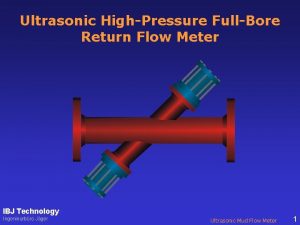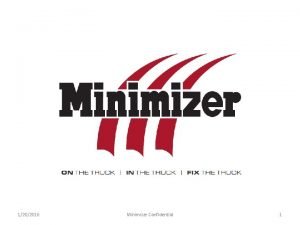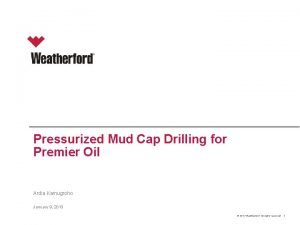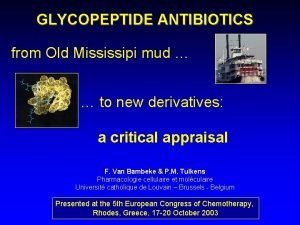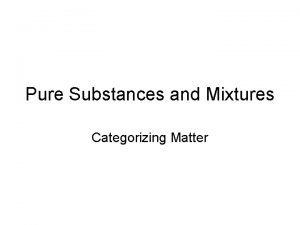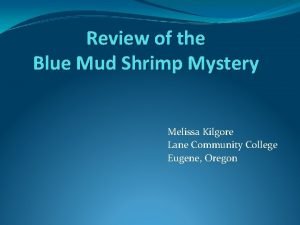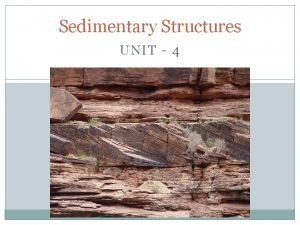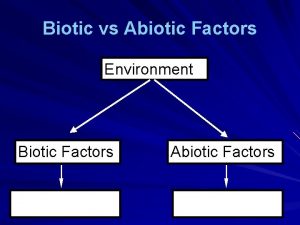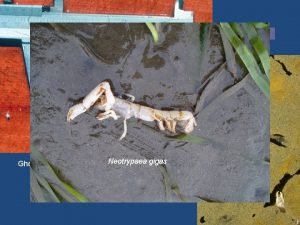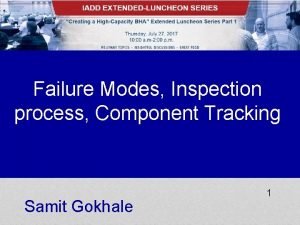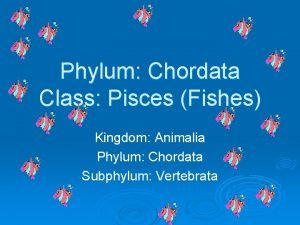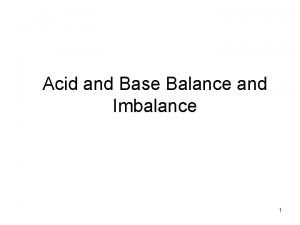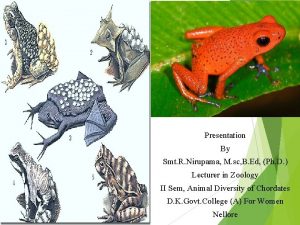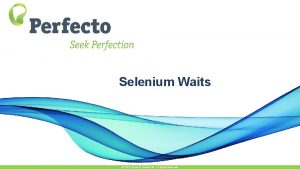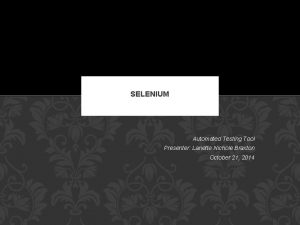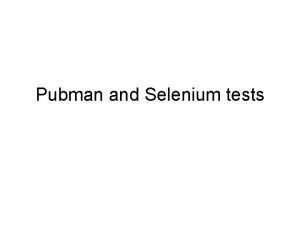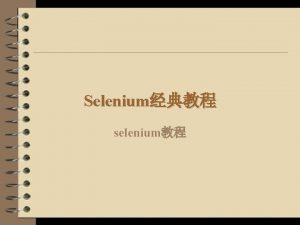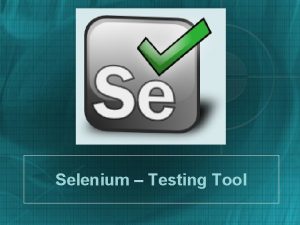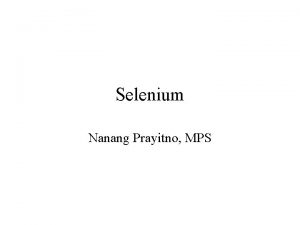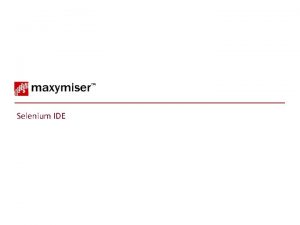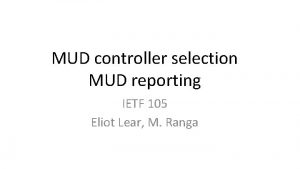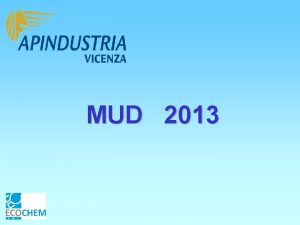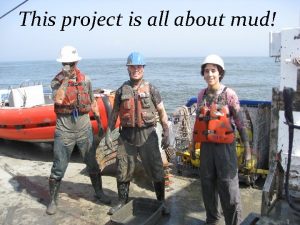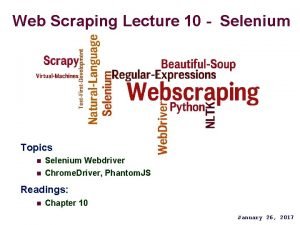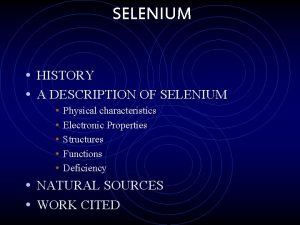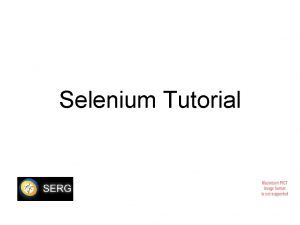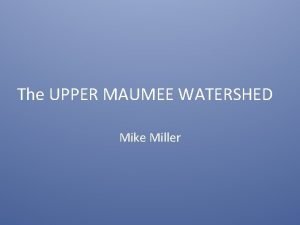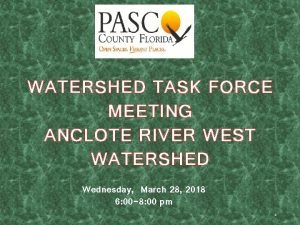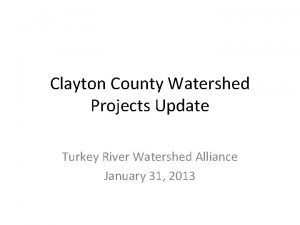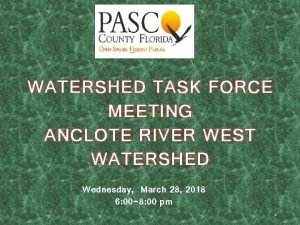Influence of Selenium in Upper Mud River Watershed



















































- Slides: 51

Influence of Selenium in Upper Mud River Watershed on Bluegill (Lepomis macrochirus) Alison M. Anderson Patricia M. Mazik Paul Ziemkiewicz

Introduction �Selenium › Naturally occurring metalloid › Associated with: �Coal seams �Phosphate deposits �Other mineral formations

Introduction Increased mobilization due to: › Irrigation › Sewage › Fly ash/coal combustion › Mining

Selenium Cycling � 4 Oxidation states › Selenite (Se. O 3 -2) › Selenate (Se. O 4 -2) › Selenides (Se -2) › Elemental selenium (Se) �Insoluble �Poorly assimilated by aquatic plants

Selenium Cycling � Immobilized › Selenate is oxidized to Selenite › Selenite binds to: �Clay �Organic particles �Forms precipitate with iron › Precipitate settles out › Sediment can be buried � Remobilized by: › Plant root absorption › Consumption by inverts and fish

Effects on Fish Benefits: › Protects DNA, lipids, and proteins If fish are deficient: › Loss coordination › Reduced growth › Reduced immune response

Effects on Fish: Adults �Impairs gas exchange › Swollen lamellae �Constricts blood vessels › Binds to hemoglobin �Unable to carry oxygen �Induce cataracts �Edema �Seleno-proteins

Seleno-proteins �Similar to sulfides �Cells cannot discriminate �Selenium substituted for sulfur �Results in dysfunctional amino acids/proteins �Accumulates in gonads, kidney, and liver

Effects on Fish: Parent to Progeny �Seleno-proteins stored in ovarian tissues �Proteins transferred to eggs › Building blocks for tissue synthesis › Metabolic fuel �External feeding › Critical period › High mortality

Effects on Fish: Parent to Progeny �Faulty proteins used for development �Results in teratogenesis: › Craniofacial deformities › Spinal deformities › Missing fins › Edema �Inability to feed leading to death

Spinal Deformities Kyphosis Lordosis Scoliosis

Objectives Determine the effects of selenium on the aquatic ecosystem of the Upper Mud River Watershed, WV 2) Determine the effects of selenium on the survival of bluegill larvae 1)

Study Site: Upper Mud River � Lower Guyandotte River Watershed � Lincoln and Boone Counties, WV � 124 ha reservoir � 4. 5 -6 m depth � Inhabitants: › › Bluegill Largemouth bass Crappie Channel catfish

Study Site: Plum Orchard Lake (Reference Site) � Paint Creek Watershed � Fayette County, WV � 81. 75 ha reservoir � 12. 2 m depth � Inhabitants: › › Bluegill Largemouth bass Channel catfish White crappie

Methods

Water Quality �October 2008 -November 2010 �Mud River (main stem and tributaries) › 20 total sites › Mined (13) › Unmined (7) �Reference › 2 sites Site

Water quality

Plum Orchard Lake (Reference Site)

Parameters Measured YSI: DO, p. H, temperature, conductivity Total and dissolved Fe, total Se, TDS, sulfates, alkalinity, hardness, TSS and TOC Picture credit: Melissa O’Neal

Sediments July 2009 Stantec, Inc. Stream (13) Reservoir (5) › Transects › Top 5 cm Picture credit: Stantec, Inc. , Lexington, KY



Plankton July, August, September 2010 Mud River Reservoir (2) Reference Site (1) 10 -20 min/ tow Surface and mid depth 95% ethanol

Benthic Macroinvertebrates November 2009 and 2010 Mud River (11) Reference Site (2) 2009: 4 kick samples 2010: 6 -8 kick samples Sorted into functional feeding group (FFG) Photo credit: Melissa O’Neal



Bluegill Tissue June 2009 and 2010 Spawning Mud River Reservoir › Whole Body (n=118) › Gonad (n=31) Reference Site › Whole Body (n=86) › Gonad (n=10) Egg selenium calculated Photo credit: John Howell

Bluegill Larval Lab Study June 2009 and 2010 2009: Entire redd collected 2010: Only shells, rocks, and branches Individual redds collected Transported to WVU wet lab


Larval Laboratory Study �Nest split into tanks › A Tanks: 28 day early life stage test for chronic toxicity › B Tanks: 9 day swim-up success �Tanks contained water from original location � 3 -days after hatching fed fine fish food and brine shrimp twice daily

Larval Laboratory Study Multiple full water changes done daily Ammonia (daily) Nitrite, alkalinity, hardness (weekly) Temperature, DO, and p. H (subset daily)

Results

Water Quality Variable Temperature (o. C) Conductivity (µs/cm) p. H DO (mg/L) Hardness (mg/L Ca. CO 3) Alkalinity (mg/L Ca. CO 3) Mined 14. 19 ± 0. 42 a Unmined Reference 13. 60 ± 0. 57 a 17. 83 ± 1. 45 b 1059. 93 ± 33. 91 a 152. 23 ± 7. 16 b 38. 38 ± 0. 66 c 7. 77 ± 0. 02 a 7. 26 ± 0. 05 b 7. 05 ± 0. 09 b 8. 91 ± 0. 32 a 8. 23 ± 0. 20 a 9. 63 ± 1. 88 a 640. 81 ± 31. 91 a 60. 14 ± 5. 49 b 13. 35 ± 0. 302 c 159. 45 ± 5. 54 a 37. 09 ± 2. 05 b 16. 87 ± 1. 37 c

Water Quality Variable TDS (mg/L) Mined Unmined Reference 1416. 57 ± 217. 61 a 139. 16 ± 16. 52 b 16. 87 ± 1. 37 c Sulfate (mg/L) 462. 24 ± 17. 11 a 39. 87 ± 8. 64 b Dissolved Iron (mg/L) 0. 068 ± 0. 007 a 0. 131 ± 0. 009 b 0. 208 ± 0. 023 c Total Iron (mg/L) 0. 606 ± 0. 189 a 0. 566 ± 0. 093 ab 0. 336 ± 0. 037 b Total Selenium (µg/L) 6. 52 ± 0. 289 a 0. 262 ± 0. 015 b 0. 194 ± 0. 021 b TOC (mg/L) 3. 46 ± 0. 36 a 3. 22 ± 0. 308 a 12. 14 ± 0. 64 c 3. 15 ± 0. 079 a

Stream Sediments 1. 4 1. 2 Selenium (µg/g DW) 1. 0 aa 0. 8 0. 6 0. 4 aa 0. 2 0. 0 Mined Unmined Site Type

Mud Reservoir Sediments a a a

Plankton a a b

Benthic Macroinvertebrates Site Filterer Gatherer Scraper Shredder Composite Unmined 2. 69 ± 0. 4 a 3. 90 ± 1. 0 a 3. 7 ± 0. 52 a 1. 9 ± 0. 72 a 3. 4 ± 0. 42 a Mined Reference 11. 7 ± 1. 4 b 12. 44 ± 1. 8 b 8. 1 ± 0. 93 b 11. 5 ± 2. 45 b 11. 1 ± 0. 87 b N/A 2. 67 ± 0. 04 a N/A 0. 88 ± 0. 12 a 2. 1 ± 0. 50 a

Bluegill Whole Body Levels a 25 20 15 10 5 b 0 Selenium (µg/g DW) 30 35 * Reference Mud Reservoir Site

Bluegill Gonad Levels 10 15 20 25 a 5 b 0 Selenium (µg/g DW) 30 * Mud Reservoir Reference Site

Larval Lab Study Variable Temperature (o. C) Dissolved O 2 (mg/L) p. H Reference Mud River Reservoir 21. 41 ± 0. 12* 22. 69 ± 0. 12 7. 87 ± 0. 09 7. 99 ± 0. 05 7. 73 ± 0. 03* 8. 36 ± 0. 008 Ammonia (mg/L) 0. 766 ± 0. 059* 0. 308 ± 0. 041 Nitrite (mg/L) 0. 01 ± 0. 001* 0. 017 ± 0. 002 20 ± 0. 0* 250 ± 0. 0 16. 35 ± 1. 13* 80 ± 0. 0 Hardness (mg/L Ca. CO 3) Alkalinity (mg/L Ca. CO 3)

Discussion

Water Quality � The mine boundary is a good delineation for site types › Sites in the mine and downstream were of high (> 5 µg/L) or moderate hazard (3 -5 µg/L) based on the hazard profile by Lemly (1995) � Levels as low as 2 µg/L can be bioaccumulated in the food chain and cause reproductive failure

Sediments All sediment samples considered no to low hazard (≤ 2 µg/g DW) Reservoir transects › All samples also considered low to no hazard at < 2 µg/g DW › Selenium seems to remain in the water column

Plankton �Mud River Reservoir (mined and unmined) sites differed from the reference site ØNot sorted to species (zooplankton, etc. )

Benthic Macroinvertebrates Mined areas greater than dietary threshold for fish (3 µg/g) and birds (7 µg/g) Did not see a significant difference between the reference site and unmined sites

Bluegill Tissues �No hazard category for whole body/gonad selenium concentrations �Egg selenium (68. 76 ± 1. 95 µg/g ) Ø High hazard (>20 µg/g)

Bluegill Tissues Toxic Effect Threshold: 5 ug/g is considered the threshold for the health and reproductive success of freshwater fish (Lemly 1995) Reference Mud Reservoir

Larval Lab Study �Did not observe deformities in larval fish �Low survival possibly due to temperature and ammonia levels

Summary �No observations of deformaties �Mined areas had higher selenium levels in the following categories: › Water selenium concentrations › Benthic macroinvertebrates › Whole body/gonad/egg concentrations

Questions?
 Genesee river watershed
Genesee river watershed Rocky river watershed
Rocky river watershed How many river basins are in nc
How many river basins are in nc Eep mobile al
Eep mobile al Darryl haddock
Darryl haddock Tukwila
Tukwila Tajewala barrage dam
Tajewala barrage dam Pearson upper saddle river
Pearson upper saddle river Upper snake teacup
Upper snake teacup Upper colorado river authority
Upper colorado river authority The upper course of a river
The upper course of a river Tajewala headworks in haryana
Tajewala headworks in haryana Upper course of a river
Upper course of a river I am the river and the river is me
I am the river and the river is me Soft mud process
Soft mud process Mooweek
Mooweek Mud cracks
Mud cracks Muram flooring images
Muram flooring images Steam temp
Steam temp Greenware ceramics definition
Greenware ceramics definition Suppose your car was mired deeply in the mud
Suppose your car was mired deeply in the mud Hebbsches lernen
Hebbsches lernen Flat roof steel truss design
Flat roof steel truss design Ks agro exports
Ks agro exports Big ball of mud
Big ball of mud Stiff mud process
Stiff mud process Mud flow meter
Mud flow meter 1202016
1202016 Two tramps in mud time summary
Two tramps in mud time summary Pressurized mud cap drilling
Pressurized mud cap drilling Vancomycin mississippi mud
Vancomycin mississippi mud Is a mud puddle homogeneous or heterogeneous
Is a mud puddle homogeneous or heterogeneous Is mud abiotic or biotic
Is mud abiotic or biotic Blue mud shrimp
Blue mud shrimp What does cross bedding indicate
What does cross bedding indicate Is mud abiotic or biotic
Is mud abiotic or biotic Mud shrimp
Mud shrimp Mud motor
Mud motor Pisces chordata
Pisces chordata Mud pie metabolic acidosis
Mud pie metabolic acidosis Hyla faber mud nest
Hyla faber mud nest Celery selenium
Celery selenium What is fluent wait in selenium
What is fluent wait in selenium Selenium automation with jira
Selenium automation with jira Automation tool selenium
Automation tool selenium How many unpaired electrons does selenium have
How many unpaired electrons does selenium have Master xpath and css selectors for selenium webdriver
Master xpath and css selectors for selenium webdriver Orbital diagram for selenium z=34
Orbital diagram for selenium z=34 Selenium grid jenkins
Selenium grid jenkins Valence electrons of gallium
Valence electrons of gallium Browserstack
Browserstack Selenium unpaired electrons
Selenium unpaired electrons
